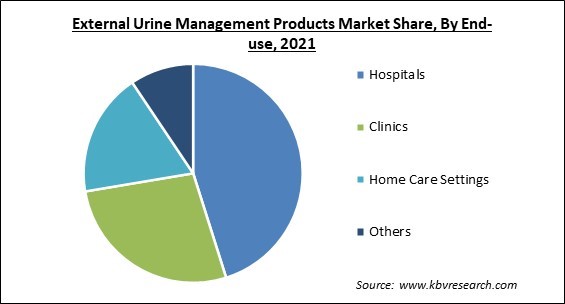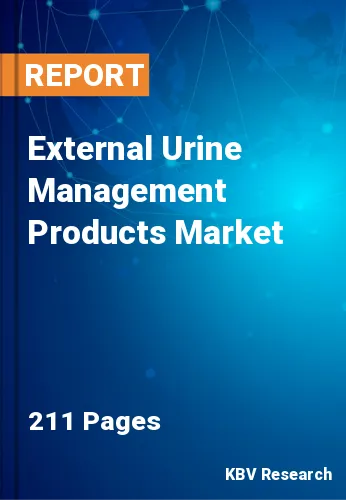The Global External Urine Management Products Market size is expected to reach $752.5 Million by 2028, rising at a market growth of 5.0% CAGR during the forecast period.
Transitioning from sanctifying grace catheters to autonomous continence is made possible by the cutting-edge external urine management device for anatomy. Fit, securement, and performance are the issues that must be addressed for urine incontinence to be properly managed. According to the American Society of Nephrology, urologic illnesses are the third most prevalent problem affecting the elderly population and are responsible for roughly 47.0 percent of doctor visits. As a result, the market's main development drivers are the high prevalence of UI, growing awareness campaigns by a variety of government and non-profit organizations, as well as and increased technology investment.

Advanced renal failure is primarily brought on by diabetes, followed by hypertension, which is thought to impact billions of people across the world. Thus, it is projected that an increase in the number of patients with end-stage renal illnesses would increase demand for external urine management solutions, supporting market growth over the projection period. Additionally, efforts to raise awareness by various governmental and charity organizations are predicted to spur market expansion. For instance, the Continence Aids Payment Scheme was introduced by the Australian government (CAPS).
Incontinence care needs for chronic or severe incontinence patients are assisted by this program. In addition, they initiated the National Continence Management Program to increase public awareness of various bowel and bladder health problems. A variety of professional organizations have raised awareness of continence across all care settings, including urogynecology, urology, gynecology, nursing, and others. The International Continence Society (ICS) founded the Continence Promotion Committee (CPC) to promote incontinence awareness, education, and services.
Internationally hospital admission rates have grown as a result of the most recent COVID-19 pandemic. The COVID-19 virus primarily affects the elderly population because those with poor or compromised immunity are more likely to contract it. The urine management solution is anticipated to be in high demand in hospital settings to deliver effective patient care as a result of the growing hospital admission rates. Therefore, even after the pandemic is finished, the market for external urine control products is anticipated to grow significantly and consistently throughout the projected period.
The rising demand for urinary catheters around the world is mostly due to the high prevalence of urine incontinence. The elderly and residents of nursing homes have greater prevalence rates. Incontinence, which cannot be treated or controlled with drugs or surgery, is managed with urinary catheters. Given that obesity and an aging population are the two main risk factors for urine incontinence, it is anticipated that the incidence of urinary incontinence would rise. They systematically examine and meta-analyze the understanding of the prevalence of urinary incontinence in older women around the world as well as the related and influential factors.

The rising elderly population is one of the biggest issues facing emerging nations worldwide. The incidence of chronic illnesses in the elderly, such as peripheral arterial disease, heart disease, and venous thromboembolism, is also anticipated to drive growth in the catheter market. The largest old population in the world, which is expanding at an unprecedented rate, is found in the Asia-Pacific region. The percentage of adults 60 and older in the population is rising, according to the World Health Organization (WHO). There were 1 billion people 60 and over in 2019, and by 2050, that figure is expected to increase to 1.4 billion.
Patients who have catheters in their bladders may have cramp-like contractions. The balloon is being forced out of the bladder, which hurts. Patients might require medicine to reduce the spasms' frequency and intensity. Catheter leaking is another problem with indwelling catheters. This may occur as a result of feces or bladder spasms. Additionally, it's critical to ensure that the catheter is draining, as leakage may be a sign of a blocked catheter. Blood or debris in the catheter tube can happen with an indwelling catheter as well. This may become a problem if the catheter drainage system gets clogged.
Based on product, the external urine management products market is classified into Male External Catheters, Female External Catheters, and Urine Collection Accessories. The female external catheters segment witnessed a significant revenue share in the external urine management product market in 2021. One of the main reasons influencing the market growth is the introduction of innovative products by the leading market players, as well as raising awareness among women regarding the management of incontinence.
On the basis of distribution channel, the external urine management products market is bifurcated into Online and Offline. The offline segment procured the largest revenue share in the external urine management product market in 2021. It is because the majority of customers continue to prefer buying through offline distribution channels since they offer product assurance, authenticity, and verification. The initial point of contact for businesses to supply goods and samples is retail outlets.
By end-use, the external urine management products market is segmented into Hospitals, Clinics, Home Care Settings, and Others. The hospital segment garnered the highest revenue share in the external urine management product market in 2021. The two main causes driving the segment's growth are the rising incidence of end-stage renal illness and the rising number of surgical procedures undertaken. A rise in hospital admissions, particularly among senior patients, was caused by the current COVID-19 outbreak.
| Report Attribute | Details |
|---|---|
| Market size value in 2021 | USD 537.6 Million |
| Market size forecast in 2028 | USD 752.5 Million |
| Base Year | 2021 |
| Historical Period | 2018 to 2020 |
| Forecast Period | 2022 to 2028 |
| Revenue Growth Rate | CAGR of 5% from 2022 to 2028 |
| Number of Pages | 211 |
| Number of Tables | 350 |
| Report coverage | Market Trends, Revenue Estimation and Forecast, Segmentation Analysis, Regional and Country Breakdown, Companies Strategic Developments, Company Profiling |
| Segments covered | Product Type, Distribution Channel, End-use, Region |
| Country scope | US, Canada, Mexico, Germany, UK, France, Russia, Spain, Italy, China, Japan, India, South Korea, Australia, Singapore, Brazil, Argentina, UAE, Saudi Arabia, South Africa, Nigeria |
| Growth Drivers |
|
| Restraints |
|
Region-wise, the external urine management products market is analyzed across North America, Europe, Asia Pacific and LAMEA. The North American region acquired the largest revenue share in the external urine management product market in 2021. It is the increased prevalence of specific disorders, such as bladder blockage, urinary tract infection (UI), urinary retention, and bladder cancer, that drives the regional market. Approximately 250,000 patients with BPH undergo surgery each year, according to the American Academy of Family Physicians (AAFP). It is typically caused by pregnancy and may also be caused by injuries to the penis, urethra, or bladder.
Free Valuable Insights: Global External Urine Management Products Market size to reach USD 752.5 Million by 2028
The market research report covers the analysis of key stake holders of the market. Key companies profiled in the report include Becton, Dickinson and Company, B. Braun Melsungen AG, Sage Products LLC (Stryker Corporation), Teleflex, Inc., Cardinal Health, Inc., Consure Medical, Hollister, Inc., Coloplast Group, Tilla Care Ltd., and Sterimed Group.
By Distribution Channel
By Product
By End Use
By Geography
The global External Urine Management Products Market size is expected to reach $752.5 Million by 2028.
Urinary Incontinence Is More Common are driving the market in coming years, however, Issues Related To The Use Of Catheters restraints the growth of the market.
Becton, Dickinson and Company, B. Braun Melsungen AG, Sage Products LLC (Stryker Corporation), Teleflex, Inc., Cardinal Health, Inc., Consure Medical, Hollister, Inc., Coloplast Group, Tilla Care Ltd., and Sterimed Group.
The expected CAGR of the External Urine Management Products Market is 5.0% from 2022 to 2028.
The Male External Catheters segment acquired maximum revenue share in the Global External Urine Management Products Market by Product in 2021 thereby, achieving a market value of $417.5 million by 2028.
The North America market dominated the Global External Urine Management Products Market by Region in 2021, and would continue to be a dominant market till 2028; thereby, achieving a market value of $285.6 million by 2028.
Our team of dedicated experts can provide you with attractive expansion opportunities for your business.

